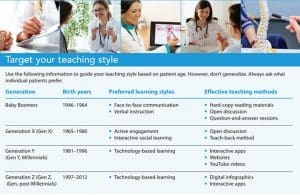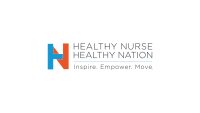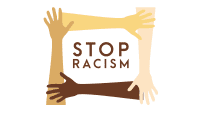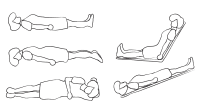Target patient teaching to match generational and individual needs.
Takeaways:
- Generational cohorts frequently have similar characteristics that influence learning preferences.
- Understanding generational preferences allows us to adapt our teaching methods for most effective patient learning.
Rose is a women’s health nurse practitioner working in a busy private obstetrics and gynecology practice. The providers rely on a collection of educational pamphlets, brochures, and information sheets for patient teaching. An annual review of the collection ensures information remains current and arranged alphabetically by diagnosis for ease in locating items quickly. The providers believe the system supports the most efficient and effective teaching for high patient volumes.
After concluding a visit with 18-year-old Ava, Rose gives her an information sheet to supplement the teaching she provided for a newly prescribed medication. The medication can have some unpleasant side effects, so she tells Ava to refer back to the sheet for any questions. Rose later finds the information sheet in the exam room. Rose is frustrated but not surprised because many patients Ava’s age seem to forget the educational materials they’re given.
The various teaching methods available accommodate preferred learning styles. As nurses and educators, we tend to use the methods that reflect how we prefer to learn. However, to teach effectively, we must consider patients’ and students’ learning preferences. Tools exist to assess preferred individual learning styles, but the time required for these assessments may preclude their use.
Frequently, learning styles are characteristic of a person’s generation: Boomer, X, Y, or Z. Targeting your teaching to generational learning preferences may provide a more effective experience for patients. (See Target your teaching style.)
Keep in mind that generational categorizations are an overview. As with any generalization, consider the individual and the cultural or regional factors that may influence personal preferences. Ask patients how they like to learn, offer examples from which to choose, and then note preferences in the electronic health record (EHR).
Baby Boomers
Various age ranges have been cited for the Baby Boomer generation, but the most cited sources place their age range between 57 and 75. They remember the Vietnam War, Watergate, and the first moon landing.
Baby Boomers tend to be curious and seek high-quality, individualized care. Although they may be less tech-savvy than other generations, they look to the internet for provider ratings and when researching health topics. Individuals of this generation prefer using technology as a means of completing a task or activity, such as registering for a webinar, rather than adopting new technology because of its availability.
Baby Boomers respond best to verbal instruction and face-to-face communication. They prefer traditional lectures and structured learning with clear guidelines, and they value team- and relationship-building. Demonstrating learning through engagement in open discussions is a preferred learning style and an effective teaching method. Baby Boomers learn best when they can share their own experiences and perspectives. When teaching this generation, consider interactive social learning methods such as question-and-answer sessions and working in small groups. When communicating with Baby Boomers, allow time for active engagement in conversations and provide concise and factual reading materials.
As their health needs increase, some Baby Boomers may ask more health-related questions using the patient portal. Providing multiple services within one location eliminates the need for travel and meets the demands of this aging generation.
Generation X
Generation X members, who are in their 40s and 50s, share some commonalities with Baby Boomers, including curiosity and responding best to verbal instructions. In addition, they’re active seekers of information and want to be educated. Gen Xers tend to be independent. Frequently referred to as latchkey children, they’re self-reliant and responsible.
As young adults, Gen Xers witnessed the early growth of the internet as it became more common in the workplace and at home. This change alone created new opportunities for communicating and learning. In the mid-1990s, online learning grew rapidly, and individuals of this generation pursued flexibility and self-direction. Like Baby Boomers, Gen Xers prefer participating in interactive social learning sessions and active engagement, which helps to explain their interest in gaming and simulation activities. For this generation, effective communication is clear and ongoing and provides immediate feedback.
Gen Xers are more accustomed to making healthcare decisions by retrieving information from various sources, such as friends, family, coworkers, TV, and online site. To satisfy this generation’s need for accuracy, provide them with evidence-based resource lists. Offer opportunities to validate learning via discussion and teach-back methods.
Generation Y
Generation Y (the Millennial Generation) ranges in age from 25 to 40. They experienced the 9/11 terrorist attacks and the Great Recession of 2008, and they are the most racially and ethnically diverse adult generation to date. As a digitally competent and highly connected generation, Millennials use the internet, mobile phones, social media, and YouTube to access information quickly and efficiently.
Millennials favor technology-based learning from multiple, easily accessible sources. They value strong personal connections and individualized experiences, but they’re less likely to access in-person healthcare. They’re more likely than previous generations to use healthcare portals.
To meet Millennials’ learning needs, provide brief, in-person verbal teaching, followed by directions to technology-based educational resources. Offer information from multiple resources such as links to websites, videos, and interactive apps. Provide digital handouts and prerecorded teaching within patient portals to meet their preferred on-demand access for learning. Engagement via telehealth is another option to meet this generation’s preference for individualized, on-demand care.
Generation Z
Generation Z (iGen or post-Millennial generation) members are between 9 and 24 years old. Knowledge about this cohort continues to emerge, but it’s been identified as the most technologically savvy of all generations. They were born with the internet and began using interactive technology before entering school. Gen Z members are more pragmatic and cautious than their Millennial counterparts. In general, individuals in this group read less and have shorter attention spans than previous generations.
To connect with this generation, use digital infographics and short, shareable videos. Gen Z learners prefer to be engaged in their learning, so interactive games and apps will help reinforce important information. Rather than having a wall of pamphlets, a digital library of infographics accessible via the patient portal is most effective.
Similar to Millennials, Gen Zers like to conduct their own research. To avoid information overload, provide evidence-based resources to help them identify credible sources. Be prepared to share apps and websites with patients in real time, and consider using QR codes so patients can access information on their smartphones during the appointment.
When communicating with Gen Z patients, use texting, face-to-face video chat, or social media as appropriate. To protect patient privacy, follow your organization’s policies that address Health Insurance Portability and Accountability Act compliance and consult the American Nurses Association social networking principles (nursingworld.org/social) for guidance on best practices. If communicating by e-mail, limit them to 140 characters to ensure information is presented concisely.
Effective individual learning
As a member of Generation Z, Ava would learn best from technology-based resources. To convey essential information more effectively, Rose’s practice can supplement their current library of hard copy materials with a readily accessible digital library of infographics, websites, and downloadable apps. To support individual learning styles, practice providers should ask new patients whether they prefer printed or on-line teaching materials and note those preferences in the EHR.
Generational cohorts have distinct characteristics that may manifest in preferred learning styles. As a nurse, understanding the particular characteristics associated with generations will help you tailor your teaching methods to the styles most effective for individual learning.
The authors work at Vanderbilt University School of Nursing in Nashville, Tennessee. Ginny Moore is an associate professor of nursing and director of the women’s health nurse practitioner specialty. Shaunna Parker is an instructor of nursing. Lindsey Baksh is an assistant professor of nursing.
References
Boysen PG II, Daste L, Northern T. Multigenerational challenges and the future of graduate medical education. Ochsner J. 2016;16(1):101-7.
Dimock M. Defining generations: Where Millennials end and Generation Z begins. Pew Research Center. January 17, 2019.
Evans KH, Ozdalga E, Ahuja N. The medical education of Generation Y. Acad Psychiatry. 2016;40:382-5. doi:10.1007/s40596-015-0399-5
Hampton D, Welsh D, Wiggins AT. Learning preferences and engagement level of Generation Z nursing students. Nurse Educ. 2020;45(3):160-4. doi:10.1097/NNE.0000000000000710
Heath S. Understanding generational differences in patient engagement. Patient Engagement HIT. March 29, 2016.
Integrated Healthcare Executive. How generational factors impact patient engagement. May 2016.
Lowell VL, Morris Jr J. Leading changes to professional training in the multigenerational office: Generational attitudes and preferences toward learning and technology. Perf Improvement Qrtly. 2019;32(2):111-35. doi:10.1002/piq.21290
Majors M. How to engage different generations with their healthcare benefits. Managed Healthcare Executive. June 17, 2018.
Venter E. Bridging the communication gap between Generation Y and the Baby Boomer generation. Int J Adolesc Youth. 2017;22(4):497-507. doi:10.1080/02673843.2016.1267022
Williams CA. Nurse educators meet your new students: Generation Z. Nurse Educ. 2019;44(2)59-60. doi:10.1097/NNE.0000000000000637



















